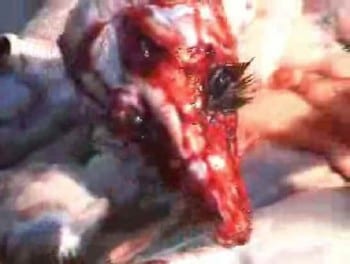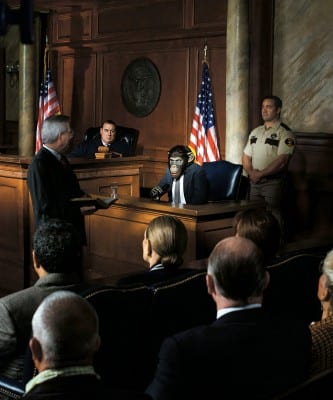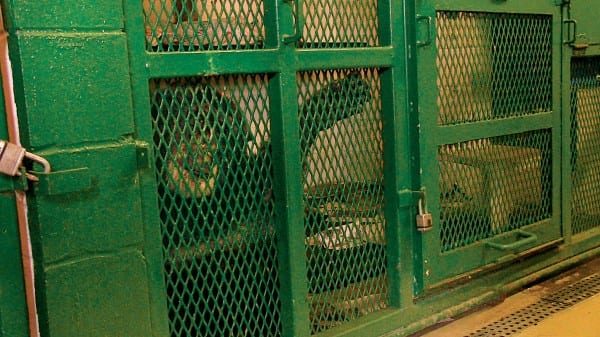“We’re all instantly repelled by that, of course,” Wise said. When he asked his students that question, they “get all tied up in knots and say things like ‘because she has a soul’ or ‘all life is sacred.’ I say: ‘I’m sorry, we’re not talking about any characteristics here. It’s that she has the form of a human being.’ Now I’m not saying that a court or legislature can’t say that just having a human form is in and of itself a sufficient condition for rights. I’m simply saying that it’s irrational. . . . Why is a human individual with no cognitive abilities whatsoever a legal person with rights, while cognitively complex beings such as Tommy, or a dolphin, or an orca are things with no rights at all?”
The other advantage of habeas corpus cases, Wise said he realized, is they allow him to circumvent federal courts, where judges tend to rule in accordance with what they perceive to be the original intentions of pre-existing statutes and laws. State courts, by contrast, where almost all habeas corpus cases are heard, are the home of common law — what Wise often characterizes as a breeding ground of ever-evolving laws where for the past 800 years judges have been making decisions based more on the available evidence and on broader principles like equality and liberty and what is morally right. The common law is the realm in which Wise feels he has the best chance to succeed. “I have to present an argument that a judge can grasp quickly. I have to go bang, bang, bang, detailing the distinct qualities of my clients. We’re definitely asking a judge to make a leap of faith here; what some might see as a quantum leap. My job is to make it seem as small as possible.”
No recent case better underscores the unique nature of Wise’s present endeavor than the one that seemed, at first, to most resemble it. In October 2011, despite Wise’s objections, People for the Ethical Treatment of Animals (PETA) filed a lawsuit on behalf of five orcas at SeaWorld San Diego and SeaWorld Orlando, accusing the theme park of violating the 13th Amendment, which abolished slavery. The suit was dismissed by Judge Jeffrey Miller of the U.S. District Court for Southern California, who wrote in his ruling that “the only reasonable interpretation of the 13th Amendment’s plain language is that it applies to persons, and not to nonpersons such as orcas.”
Wise was furious over what he considered the grossly premature timing of PETA’s case. After the judge’s decision, Wise called a PETA lawyer to “share his thoughts” with him. Natalie Prosin was on that call too. “She really let me have it afterward,” Wise said. “She said, ‘You acted like you were the professor and he was your student, lecturing him for over 30 minutes on why his case was so bad.’ I said: ‘I know. And frankly 30 minutes wasn’t nearly enough.’ It was idiotic to invoke the Constitution the first time around. You know maybe in 50 years, after you’ve already laid a foundation of courts recognizing that nonhuman animals could be considered legal persons under the common law. That’s precisely why we’re avoiding the federal courts.”
As hasty an overreach as Wise thought PETA’s legal gambit to be, the Nh.R.P.’s has been plodding and precise. As many as 70 volunteers have been working over the past four years on different facets of his legal offensive. Perhaps the most important is the Nh.R.P.’s Science Working Group, which collaborates with Dr. Lori Marino, an Emory University specialist in the cetacean brain and the evolution of animal intelligence. This group is assigned the task of gathering available research and expert testimony on the cognitive abilities of the plaintiffs that the Nh.R.P. plans to represent.
As recently as 10 years ago Wise’s effort would have been laughed out of a courtroom. What has made his efforts viable now, however, is in part the advanced neurological and genetic research, which has shown that animals like chimpanzees, orcas and elephants possess self-awareness, self-determination and a sense of both the past and future. They have their own distinct languages, complex social interactions and tool use. They grieve and empathize and pass knowledge from one generation to the next. The very same attributes, in other words, that we once believed distinguished us from other animals. Wise intends to wield this evidence in mounting the case that his clients are “autonomous beings,” ones who are able, as Wise defines that term, “to freely choose, to self-determine, to make their own decisions without acting from reflex or innate behavior.” He sees these abilities as the minimum sufficient requirement for legal personhood.
Another element of the Nh.R.P.’s strategy is the Legal Working Group, which selects optimal jurisdictions for their lawyers and then finds potential clients there, a reversal of the typical process in which a lawyer has a client and then argues their case in whatever jurisdiction that client happens to live. For the first set of cases, the 20 or so members of the Legal Working Group scoured the records on the habeas corpus rulings of all 50 states and composed memos, each at least 15 pages, before finally settling on New York, where seven privately owned chimps were being held throughout the state.
Wise, Prosin, Stein and Monica Miller, another lawyer, filed habeas corpus petitions on behalf of four of the chimps (the three others died before the Nh.R.P. could do so). The day after Tommy’s case was presented, the lawyers were in Niagara Falls, N.Y., filing on behalf of a chimp there named Kiko. Two days after that, they traveled to Riverhead, N.Y., on Long Island, to file a third suit in the name of Leo and Hercules, two chimps being kept at Stony Brook University for studies on human locomotion.
In addition, the Nh.R.P.’s Sociological Working Group has been collecting whatever information it can on the judges within a prospective jurisdiction, everything from their sex, age and political party to their leisure activities and whether or not they own pets. It’s all by way of getting the best sense of the kind of judge the plaintiffs might be facing.
The hope is that they will get what Wise calls a “substantive-principles judge,” one not as bound by precedent, who makes what he or she believes is a just decision, regardless of what ramifications the decision may have. A judge like Lord Mansfield, who before setting the slave James Somerset free, said, “Fiat justitia, ruat coelum” (“Let justice be done, though the heavens may fall”).
“I’m looking for a Lord Mansfield,” Wise told me, “but as I often tell my students, be careful what you wish for. You may get a principles judge, and it turns out that the principles the judge holds are the ones that make him say: ‘You lose. I don’t agree with your principles. I agree with the principle that God created humans, and we all have souls, and we’re special, and nonhuman animals do not and so aren’t.’ And in that case you’ve just shot yourself in the head.”
Of course, a number of people both in the legal world and beyond find the very premise of seeking legal personhood for animals an oxymoron. There are, they assert, already ample protections available under current animal-welfare laws, on both the federal and state levels, without having to go down the practically and philosophically fraught path of extending a human right to a nonhuman.
Richard Epstein, a New York University law professor, is an outspoken critic of Wise and of the notion of extending rights to animals. He bridles at what he sees as the potential practical consequences of such an outcome, a slippery-slope effect that would eventually abolish long-established institutions like the agriculture-and-food-production industry. “[T]here would be nothing left of human society,” Epstein once asserted in a 1999 essay, “The Next Rights Revolution?” “if we treated animals not as property but as independent holders of rights.” He also considers Wise’s legal approach to be “completely misguided.”
“Steven is extremely ingenious,” Epstein told me in his N.Y.U. office in January. “I don’t think he’s a great intellect. He’s a man of tremendous persistence. He just doesn’t think there is any serious argument that can be made on the other side. It’s like watching someone with tunnel vision. . . . My attitude is this: There are two ways to think about it. He thinks of it as rights. I think about it as protection. You can guarantee the things he’s seeking through animal-protection legislation without calling them rights. I mean, you may want to enforce the laws better. I just think the argument of making animals into sort of human beings is what’s crazy.”
But Wise contends that present forms of protection are effectively unenforceable in a case like Tommy’s, primarily because under current animal-welfare laws on both the state and federal levels, it isn’t illegal to keep a chimp in a cage, Tommy’s present owner, Pat Lavery, has said that Tommy’s cage is legal and inspected annually. In those cases in which cages do not meet proper standards, animals are rarely taken from their owners because they’re still considered private property.
Ultimately, Wise is not interested in trying to distinguish between bad and better forms of captivity. What he is trying to provoke is a paradigm shift in how we think of our relationship to animals. “One day we’ll be filing a suit on behalf of SeaWorld orcas,” Wise said, “these amazingly intelligent and social animals who were captured from the ocean and are now being kept in a tiny pool, and yet obviously it’s not illegal. SeaWorld is making tens of millions of dollars a year. No one is suggesting they be charged with cruelty to animals, and nobody has any ideas about how to get those orcas out. It’s the same thing with chimpanzees. So the reason we chose habeas corpus over other causes of action is that it’s the only possible remedy.”
Even some in the animal rights community have criticized Wise for the anthropocentrism of stressing his clients’ similarity to us rather than that basic Benthamic barometer of “can they suffer?” For Wise, though, “can they suffer?” is still the defining arbiter. It’s simply one that has been lent a whole new meaning and level of urgency by something obviously unavailable to a 19th-century British philosopher: the ever-growing body of scientific evidence pushing us into the increasingly discomfiting corner of knowing that, in the end, it isn’t really his clients’ likeness to us but their distinctly different and yet compellingly parallel complexity that now may command not just a philosophical regard but a legal one as well.
At just past 2 p.m. on Dec. 2, Nh.R.P.’s legal team of Wise, Prosin and Stein sat at the plaintiff’s table in the main courtroom of the Montgomery County courthouse in Fonda, N.Y., nervously awaiting the entrance of Justice Joseph M. Sise.
Wise had told me what he could expect from a decision made in a lower court like this one. “At this level,” he said, “it’s not going to be an emotional decision, but a very practical, serious one. The judge is going to want to rule in a way in which he feels reasonably supported by the existing laws. He doesn’t want to look like an idiot. But if he’s willing to hear the case, or even write a decision on it, as long as his rejection goes on the record, we can go to the Court of Appeals. That’s where you can argue with more emotion and where most common law gets made anyway.”
On the drive from Johnstown to the courthouse, Prosin was on her phone, trying to get information on Sise, a justice on the State Supreme Court. “Brother was a judge,” Prosin muttered. “Father a judge. He’s young. Graduated law school 1988. Conservative Republican.” There was, however, little clear indication of whether he might be a Lord Mansfield.
Now in the courtroom, a voice called, “All rise.” Through a sudden opening in the room’s oak paneling, Sise, a tall, lean, dark-haired man in his early 50s, emerged and strode swiftly to his seat at the bench. Wise listened, rapt as Sise spoke the words he had been waiting his entire career to hear in court: “This is in the matter of . . . an application . . . seeking a writ of habeas corpus for a nonhuman.”
When Sise asked Wise why Article 70 of the Civil Practice Law and Rules — New York State’s habeas corpus provision — “should be enlarged to include an animal, a chimpanzee,” the typically voluble Wise struggled to speak. You could almost hear the gears of his brain snagging, the various lines of argument that he had been planning and honing over the years for this very moment, getting all bound up now into one hopeless snarl.
“I couldn’t believe I was finally about to argue this case before a judge,” he told me later. “I really got choked up for a moment.”
The hearing took no more than 20 minutes. The justice interrupted often at the start, pre-empting Wise’s attempts at building an argument, knocking him back on his heels with repeated questions about why Article 70 was the only form of redress in this instance.
“Isn’t there a different way,” Sise asked at one point, “for you to petition the court for . . . relief other than attempting to have the Supreme Court . . . enlarge the definition of ‘human-being’ under Article 70 to include an animal?”
“We are most definitely not asking the court to redefine the term ‘human being,’ ” Wise boomed, his heart at last having loosened its grasp on his throat. “We brought a writ of habeas corpus because [it] is aimed at the denial of a legal person’s, not necessarily a human being’s, but a legal person’s right to bodily liberty.”
Wise next began to make his case for why all chimps in New York should be declared legal persons, arguing that they are fully autonomous beings. “Says who?” Sise asked. “And . . . I’m asking the question because that’s beyond your ken and beyond my ken. It’s beyond the ken of the normal fact-finder. You’re stating something that only expert testimony could supply.”
Wise quickly cited the affidavits from the world’s leading primatologists. The previously curt and pre-emptive Sise fell silent, leaning in, his head nodding slightly.
“So what is it that you’re asking the court to do in terms of Article 70, make an exception for chimpanzees only?” Sise asked. “You understand the question, right? The legal conundrum the court is in based upon your argument?”
“We are, in a specific, legal way . . . simply asking that you issue the writ of habeas corpus on behalf of Tommy,” Wise began calmly. “We are saying the reason that this court should do that is Tommy, as these experts pointed out, is autonomous. . . . Being a member of the species homosapiens is indeed a sufficient condition for personhood, but there are other sufficient conditions for personhood, as well. . . . Autonomy is an extraordinarily important attribute, and we argue . . . that a being who is autonomous, who can choose, who is self-aware, these, your honor, are essentially us.”
“All right,” Sise said. “What else? Anything else?”
Wise appeared spent. “No, your honor.”
The justice sat back in his chair. “Your impassioned representations to the court are quite impressive,” he said. “The court will not entertain the application, will not recognize a chimpanzee as a human or as a person . . . who can seek a writ of habeas corpus under Article 70. I will be available as the judge for any other lawsuit to right any wrongs that are done to this chimpanzee, because I understand what you’re saying. You make a very strong argument. However, I do not agree with the argument only insofar as Article 70 applies to chimpanzees. Good luck with your venture. I’m sorry I can’t sign the order, but I hope you continue. As an animal lover, I appreciate your work.”
I managed to get hold of Sise on the phone a few weeks later and asked him about his ruling. “I thought they should have an opportunity to make their argument as to why Article 70 should be enlarged to include nonhumans,” Sise said. “Ultimately, I felt that they had the right to make a record so that they could appeal. I thought, Here’s this group of lawyers, living and dying this, they deserve due process, and they deserve to be told just how impressed at least I was by the effort they’re making on behalf of animals.”
I said that I imagined it wasn’t the sort of case that came across his desk very often.
“Obviously not,” he said, laughing. “But in terms of the legal questions before the court, it was very similar to many applications we have: Whether or not a petition has been rightfully filed under an article and whether that article applies. So the legal analysis was not novel, although the facts certainly were.”
The Nh.R.P. ended up losing their other two New York cases as well, with the judges arguing that the petitioners had other remedies they could seek through existing animal-protection laws. But before Justice Ralph A. Boniello III, of the State Supreme Court for the County of Niagara, rendered his decision, Wise was given full leave to air for the record his petition on behalf of Kiko. The justice called the argument “excellent” but concluded that he was “not prepared to make this leap of faith.”
On balance, Wise and his colleagues emerged from their first round of suits ecstatic. They had all they needed to take the cases to the appellate level to keep making their argument.
In February, the Nh.R.P. lawyers were in New York City for a weekend-long meeting to refine their pending appeals for later this year and to decide on the next roster of plaintiffs. In a couple of weeks Wise would be back on the road, reviewing new prospects: mostly chimps and a few circus elephants. For the latter, Wise told me, the California-based animal-protection organization PAWS is willing to provide sanctuary on a case-by-case basis.
Over dinner one night, I asked Wise about the oft-stated position that there are already ample forms of redress for the likes of Tommy. Did he ever feel that gaining legal rights for such creatures is really a symbolic gesture? As Richard Epstein put it in his N.Y.U. office, “He’s just sticking his fingers in your eyes.”
“In whose eyes?” Wise said, smiling. “In the world’s eye? For what purpose? Look, he’s a law professor. He doesn’t practice law. If he does, it isn’t this kind of law. It’s hardly symbolic for the animals.”
I reminded Wise at one point that he, the crusader against speciesism and ordained hierarchies, has been accused of erecting a speciesist hierarchy of his own by singling out only certain sufficiently sophisticated animals to represent in court. I asked him, for example, if he would also consider filing a suit on behalf of a captive vervet monkey or a tortoise or a rat.
“I don’t know the answer to the question,” he responded. “The reason I do know the answer for the animals we are currently choosing to represent is we’ve spent years trying to understand what their cognitive capabilities are. But we feel very comfortable in saying that for any nonhuman animal who is autonomous, whatever species they may be, then we will go into court and make the argument that they have a sufficient condition for rights. We’ve never claimed it’s a necessary condition, and as the public debate evolves, people may be making other arguments based on other factors. I mean, how autonomous do you have to be anyway? Look at human beings. We all have rights, and we range from drooling, nonautonomous people to people who are extraordinarily autonomous, like Richard Epstein.”
Wise told me he was well aware of the fact that for creatures like Tommy, a victory in court could only result in transfer to a kinder type of captivity. The larger significance of winning for Wise, however, is the clear message it sends about the wrongfulness of holding captive a chimp or a circus elephant or a SeaWorld orca in the first place.
In a 2001 debate with Peter Singer, Judge Richard Posner of the United States Court of Appeals for the Seventh Circuit — who has debated Wise as well — argued that only facts will lead to according animals rights, not intuitions. “Much is lost,” Posner stated at one point, “when . . . intuition is made a stage in a logical argument.”
And yet in that same debate, Posner stated that the special status we humans accord ourselves is based not on tests or statistics but on “a moral intuition deeper than any reason that could be given for it and impervious to any reason that you or anyone could give against it.” That inherent irrationality at the heart of humanity’s sense of exceptionalism is what most worries Wise.
“It’s those deeply held beliefs that I’m concerned about,” he told me. “The judge who either doesn’t recognize that he’s ruling against us on those grounds, or who does, and decides that way anyway. Our challenge is to lay bare that bias against our facts. I will say: ‘Judge, you know, we’ve been here before. We’ve had people who’ve essentially said, “I’m sorry, but you’re black.” Or “I’m sorry, you’re not a male or a heterosexual.” And this has led us to some very bad places.’ ”
Much like other civil rights movements, the Nh.R.P.’s efforts are designed to be a systematic assault; a continued and repeated airing of the evidence now at hand so that other lawyers and eventually judges and society as a whole can move past what Wise considers the increasingly arbitrary distinction of species as the determinant of who should hold a right.
Wise said he doesn’t expect to win in the first round of suits, and neither does he in the fifth or the 20th. “For me this has been a 25-year plan. All my books and my courses were designed to help me think through this problem. Now I want to spend the rest of my life litigating. If we lose, we keep doing it again and again, until we find a judge who doesn’t feel that the way is closed off. Then our job is to produce the facts that will allow that judge to make that leap of faith. And when it happens, it will be huge. I wouldn’t be spending my life on this otherwise.”

 Roland Windsor Vincent is an Animal Rights activist, political strategist, attorney, public speaker, and writer. He is now TGP’s Special Editor for Socialism, Environment & Animal Rights.
Roland Windsor Vincent is an Animal Rights activist, political strategist, attorney, public speaker, and writer. He is now TGP’s Special Editor for Socialism, Environment & Animal Rights.













